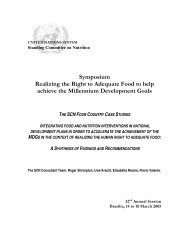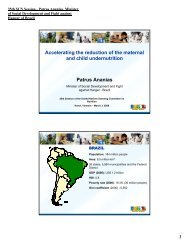Universal Salt Iodization (USI) - FTP Directory Listing
Universal Salt Iodization (USI) - FTP Directory Listing
Universal Salt Iodization (USI) - FTP Directory Listing
- No tags were found...
Create successful ePaper yourself
Turn your PDF publications into a flip-book with our unique Google optimized e-Paper software.
12FEATURESwww.unsystem.org/scnGlobal Progress in Addressing Iodine Deficiency through <strong>Universal</strong> <strong>Salt</strong> <strong>Iodization</strong>:The Makings of a Global Public Health Success Story—The Second Decade (1995-2007)Kul C. Gautam, (Deputy Executive Director, UNICEF)Global progress towards the elimination of iodine deficiency disorders (IDD) has been tremendous. Although the story isnot yet over, the history and evolution of the global fight to eliminate IDD offers many lessons that could be applied toother public health efforts. Securing political commitment, ensuring iodized salt supply, forming national oversightcoalition and partnerships with the salt industry together with effective education, communications and monitoringsystems are key elements of the global success of the massive reductions in IDD through <strong>USI</strong>. As salt iodizationprogrammes mature, many countries have transitioned from relying upon donor-support to self-financing. Ensuringsustainability remains one of the key challenges in the global fight to eliminate IDD.Key words: IDD, iodine, iodine deficiency disorder, iodization, global, progress, programme maturation, salt, <strong>USI</strong>IntroductionIodine deficiency is the world’s single greatest cause of preventable mental retardation (Hetzel 1983). It isespecially damaging during early pregnancy and childhood. A mild iodine deficiency can cause a significantloss of learning ability, as well as other symptoms such as goitre, an abnormal enlargement of the thyroidgland. In its most severe form, iodine deficiency causes cretinism, stillbirth and miscarriage, and increasesinfant mortality (Delange 1994, 1999). A meta-analysis of 18 studies concluded that iodine deficiency alonelowered mean IQ scores by 13.5 points (Bleichrodt and Born 1994). The consequences of iodine deficiencyare thus measurable in terms of loss of economic productivity. The good news is that all of these disordersare easily preventable (UNICEF/WHO, 1994).The World Health Organization (WHO) and United Nations Children’s Fund (UNICEF) have recommended<strong>Universal</strong> <strong>Salt</strong> <strong>Iodization</strong> (<strong>USI</strong>) as a safe, cost-effective and sustainable strategy to ensure sufficient intake ofiodine by all individuals (UNICEF/WHO 1994).In fact, salt iodization could well be the most successful public health effort in the past two decades. And ifone takes into account the resulting drastic reduction in the risk of intellectual impairment caused by iodinedeficiency, salt iodization might even be considered one of the greatest public health achievements of the20 th Century. The World Bank estimated that each dollar dedicated to the prevention of Iodine DeficiencyDisorders (IDD) would yield a productivity gain of $28, supporting the widely held view that elimination ofiodine deficiency is one of the most cost-effective intervention programmes (World Bank 1994). A group ofthe world’s leading economists confirmed during the Copenhagen Consensus meeting that the benefit-costratio for salt iodization could be as high as 520, the highest among all interventions related to hunger andmalnutrition (Behrman 2004).Global efforts were initiated in 1990 when the World Health Assembly passed a resolution (WHA 43.2) whichadopted the goal of eliminating iodine deficiency as a public health problem in all countries by year 2000. <strong>Salt</strong>iodization programmes were accelerated when the necessary political will was generated through the “WorldSummit for Children” with the support of the United Nations (UN) System (UNICEF 1998). That Summit wasthe largest gathering of world leaders in history up to that time. It brought together 71 heads of State andGovernment and nearly 100 other leaders, mostly at the ministerial level. The World Summit set a goal ofvirtual elimination of iodine deficiency as part of its Plan of Action for child survival, development andprotection (UNICEF 1990). This support led to the development of an extraordinary global partnership ofcountries, UN, bilateral agencies, technical institutions and the salt industry.Prior to 1995 the iodization of salt was indicated only in countries that were recognized as having the IDDscretinism and goitre, based on surveys. After 1995 all countries had to iodize salt regardless of having aproven IDD problem and <strong>USI</strong> was globally adopted as the main strategy to eliminate IDD. This resulted in afar greater acceleration during the second period (1995-2000) (Shrimpton et al 2002). The original commitmentwas again renewed at the UN General Assembly Special Session on Children (UNGASS) in 2002. In itsDeclaration - “World Fit for Children”, leaders of some 190 high-level national delegations reinforced the needSCN NEWS # 35 back to contents







